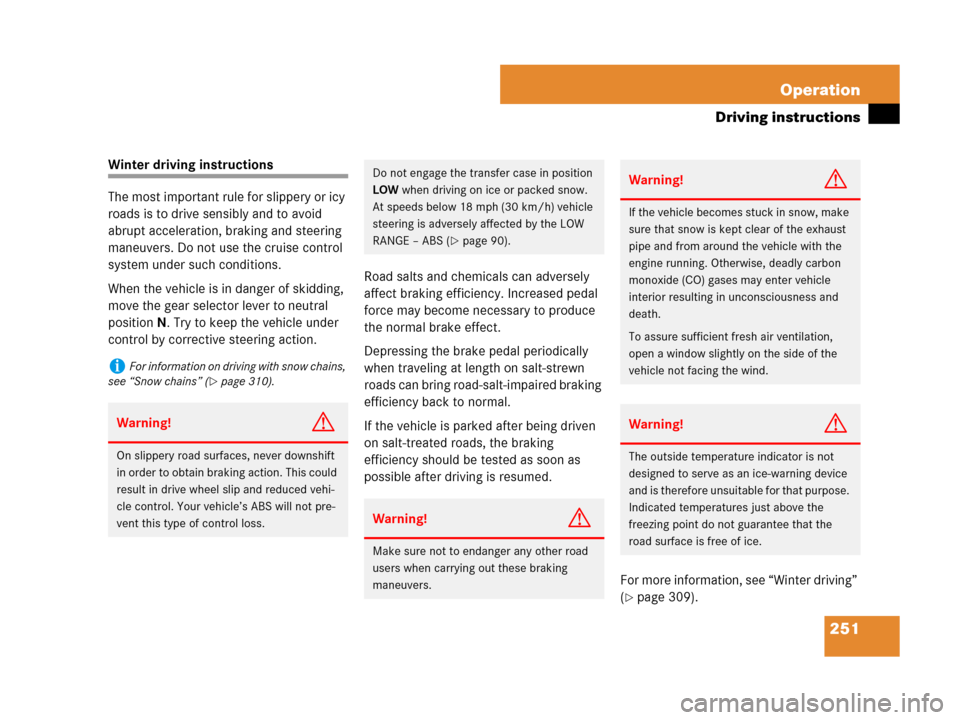Page 252 of 457

251 Operation
Driving instructions
Winter driving instructions
The most important rule for slippery or icy
roads is to drive sensibly and to avoid
abrupt acceleration, braking and steering
maneuvers. Do not use the cruise control
system under such conditions.
When the vehicle is in danger of skidding,
move the gear selector lever to neutral
positionN. Try to keep the vehicle under
control by corrective steering action.Road salts and chemicals can adversely
affect braking efficiency. Increased pedal
force may become necessary to produce
the normal brake effect.
Depressing the brake pedal periodically
when traveling at length on salt-strewn
roads can bring road-salt-impaired braking
efficiency back to normal.
If the vehicle is parked after being driven
on salt-treated roads, the braking
efficiency should be tested as soon as
possible after driving is resumed.
For more information, see “Winter driving”
(
�page 309).
iFor information on driving with snow chains,
see “Snow chains” (
�page 310).
Warning!G
On slippery road surfaces, never downshift
in order to obtain braking action. This could
result in drive wheel slip and reduced vehi-
cle control. Your vehicle’s ABS will not pre-
vent this type of control loss.
Do not engage the transfer case in position
LOW when driving on ice or packed snow.
At speeds below 18 mph (30 km/h) vehicle
steering is adversely affected by the LOW
RANGE – ABS (
�page 90).
Warning!G
Make sure not to endanger any other road
users when carrying out these braking
maneuvers.
Warning!G
If the vehicle becomes stuck in snow, make
sure that snow is kept clear of the exhaust
pipe and from around the vehicle with the
engine running. Otherwise, deadly carbon
monoxide (CO) gases may enter vehicle
interior resulting in unconsciousness and
death.
To assure sufficient fresh air ventilation,
open a window slightly on the side of the
vehicle not facing the wind.
Warning!G
The outside temperature indicator is not
designed to serve as an ice-warning device
and is therefore unsuitable for that purpose.
Indicated temperatures just above the
freezing point do not guarantee that the
road surface is free of ice.
Page 263 of 457

262 Operation
Driving instructions
Telephones and two-way radios
Radio transmitters, such as a portable
telephone or citizens band unit should only
be used inside the vehicle if they are
connected to an antenna that is installed
on the outside of the vehicle.
Refer to the radio transmitter operation
instructions regarding use of an external
antenna.Catalytic converter
Your Mercedes-Benz is equipped with
monolithic-type catalytic converters, an
important element in conjunction with the
oxygen sensors to achieve substantial
control of the pollutants in the exhaust
emissions. Keep your vehicle in proper
operating condition by following our
recommended maintenance instructions
as outlined in your Maintenance Booklet.
Warning!G
Never operate radio transmitters equipped
with a built-in or attached antenna (i.e. with-
out being connected to an external antenna)
from inside the vehicle while the engine is
running. Doing so could lead to a malfunc-
tion of the vehicle’s electronic system,
possibly resulting in an accident and/or
personal injury.
!To prevent damage to the catalytic convert-
ers, use only premium unleaded gasoline in this
vehicle.
Any noticeable irregularities in engine operation
should be repaired promptly. Otherwise, exces-
sive unburned fuel may reach the catalytic
converter, causing it to overheat and potentially
start a fire.
Warning!G
As with any vehicle, do not idle, park or
operate this vehicle in areas where combus-
tible materials such as grass, hay or leaves
can come into contact with the hot exhaust
system, as these materials could be ignited
and cause a vehicle fire.
Page 380 of 457

379 Practical hints
Replacing bulbs
Notes on bulb replacement
�Only use 12-volt bulbs of the same type
and with the specified watt rating.
�Switch lights off before changing a bulb
to prevent short circuits.
�Always use a clean lint-free cloth when
handling bulbs.
�Your hands should be dry and free of oil
and grease.
�If the newly installed bulb does not
come on, contact an authorized
Mercedes-Benz Light Truck Center.Have the LEDs and bulbs for the following
lamps replaced at an authorized
Mercedes-Benz Light Truck Center:
�the additional turn signal lamps in the
exterior rear view mirrors
�the high mounted brake lamp
�the Bi-Xenon lamps
�the locator lighting lamps in the
exterior rear view mirrors
Warning!G
Bulbs and bulb sockets can be very hot.
Allow the lamp to cool down before
changing a bulb.
Keep bulbs out of reach of children.
Halogen lamps contain pressurized gas.
A bulb can explode if you:
�touch or move it when hot
�drop the bulb
�scratch the bulb
Wear eye and hand protection.
Because of high voltage in Xenon lamps, it is
dangerous to replace the bulb or repair the
lamp and its components. We recommend
that you have such work done by a qualified
technician.
!Do not replace the LEDs yourself. You could
otherwise damage the LEDs or parts of the vehi-
cle. Only have the LEDs replaced at an autho-
rized Mercedes-Benz Light Truck Center.